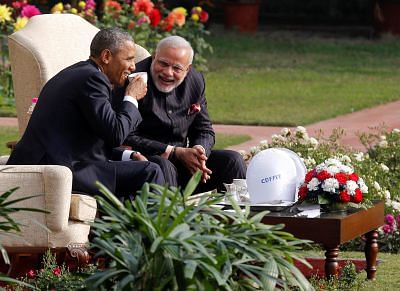Modi-Obama bonhomie in Delhi
Modi-Obama bonhomie in Delhi

President Barack Obama was in Delhi between 27 and 27 January. He was the first US President to be the Chief Guest at India's Republic Day parade. Obama is also the first US President to visit India twice while in office. Republic Day parade is a colourful pageant held in Delhi from the Raisina Hill (near Rashtrapati Bhavan) along the Rajpath past the landmark India Gate.
The visit, which was seen as a symbol of US-India friendship, had also achieved a major breakthrough. Three documents were issued – the 59-paragraph US-India Joint Statement titled “Shared Effort: Progress for All”, India-US Delhi Declaration of Friendship, and US-India Joint Strategic Vision for the Asia-Pacific and Indian Ocean Region.
The most significant breakthrough was in operationalising the stalled civil nuclear deal. The Joint Statement released on July 18, 2005 by President George Bush and Prime Minister Manmohan Singh introduced the “123 Agreement” also known as “US-India Civil Nuclear Agreement”, under which India agreed to separate its civil and military nuclear facilities and place all its civil nuclear facilities under IAEA. But because India had not signed the Non-Proliferation Treaty (NPT) it took three years before US Congress gave final approval to the deal on October 1, 2008. The deal was supposed to lift US moratorium on nuclear trade with India, allow US companies to build nuclear reactors in India and provide nuclear fuel for its civilian energy program. However, two issues held up implementation of the deal.
The first was related to India's liability law. The Congress-led UPA government was forced to pass “Civil Liability for Nuclear Damages” in August 2010, when BJP and the Left Front stiffly opposed the agreement. The bill allowed operators (i.e. India) to sue suppliers (from US) in case of accidents but suppliers and the US government were against such a condition. The second problem was that the US insisted on tracking fuel supplies to reactors. India was against this condition because of it being intrusive.
After formal talks at Hyderabad House, Modi and Obama announced a breakthrough. India will create a “pool of insurance” to take care of damages in case of accidents – meaning US reactor suppliers will not be liable for accidents. US withdrew the 'fuel tracking' clause as India agreed to sign “Additional Protocol” with IAEA, which will allow more intrusive inspections of its civilian nuclear installations.
India is already a nuclear-weapon state but not a NPT signatory. Fear is that this deal may lead to further proliferation against which US is vocal. The devil always lies in the details of agreements. We shall have to wait and see how the deal is “operationalised” by US suppliers and Indian government.
Beijing has already reacted strongly to the mention of South China Sea in the “Strategic Vision.” In his Republic Day message to President Pranab Mukherjee, Chinese President Xi Jinping warned India not to step into a “zero-sum trap” that Washington was setting up for India. Beijing cautioned Delhi that US friendship was part of Washington's “pivot to Asia” strategy -- which means encircling China. Meanwhile Pakistan Army Chief General Raheel Sharif went to Beijing to discuss security and defense-related issues.
The “Friendship Declaration” lists a number of steps to enhance defense and commercial ties between the two countries. President Obama also attended the US-India CEO summit in Delhi. Speaking to the corporate leaders President Obama pledged $4 billion in lending by US banks. Though the potentials are immense, the hurdles relate to India's intellectual property rights (IPR) protection standards and India's regulatory environment. US investment is shy because the two countries still do not have any bilateral agreement on investment. Narendra Modi assured US Corporate chiefs that India will have a stable tax regime that is predictable and competitive, and vowed to make India business-friendly.
What is significant is the way Modi handled President Obama. During the press conference Modi called the US president by his first name. “Barack and I have forged a friendship. There is an openness with which we talk; we talk comfortably over the phone, joke with each other… This chemistry has not only brought us close or Washington and Delhi nearer but also the people of the two countries.
India–US relations have never been smooth. However, there has been a U-turn in American position towards India since Modi's massive electoral victory in May 2014. Narendra Modi also took the opportunity to put unpleasant incidents involving Indian diplomat Devyani Khobragade and US refusal to grant him visa behind and reached out to Washington.
With President Obama's second visit a new beginning has been made. Will this “partnership” between the two largest democracies but unequal economies sustain? Will India become an “ally” of US? And one should wait and see what the implications of Modi-Obama bonhomie are for the SAARC and the region as a whole.
The writer is a former Ambassador and Secretary